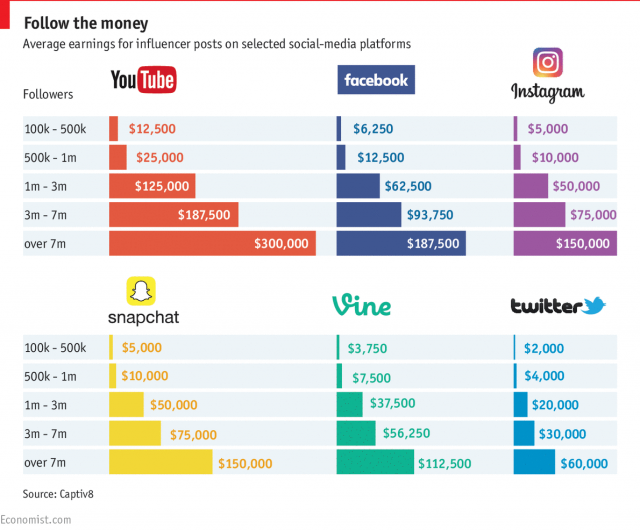5 Powerful Consumer Trends for 2019 from TrendWatching
Brands are no longer setting the pace for its consumers. In fact, it’s the other way around – these days, consumers have the upper hand over brands.
TrendWatching has identified 5 most powerful consumer trends which will influence brands in 2019.
Here they are:
- Legislative Brands
- Lab Rats
- Open Source Solutions
- Superhuman Resources
- Fantasy IRL
Let’s break them down and find out more about each one of them!
1. LEGISLATIVE BRANDS

In 2019, frustrated consumers will welcome LEGISLATIVE BRANDS: corporate interests using their significant power to call for, promote, and even impose laws that drive constructive change and make the world a better place.
TrendWatching
The concept of LEGISLATIVE BRANDS moves beyond brands supporting social issues and starting conversations by means of powerful marketing campaigns. Think Nike’s Dream Crazy and Iceland’s banned TV Christmas Advert Say Hello to Rang-tan – both powerful, both controversial. Read about them here.
In 2019, successful brands will step up their game and become a leader instead of a supporter. They will move past raising awareness; they will set out to influence and change the social issues that challenge the values they are passionate about.
The latest statistics show that more consumers link their shopping decisions to corporate values:
- 87% of consumers said they’d purchase a product because a company advocated for an issue they cared about (Cone Communications, 2017);
- 75% would refuse to purchase a product if they found out a company supported an issue contrary to their beliefs (Cone Communications, 2017);
- 86% of consumers want brands to take a stand on social issues (Shelton Group, June 2018).
Now, consumers are no longer just asking, ‘What do you stand for,’ but also, ‘What do you stand up for?’”
Alison DaSilva, Executive VP of CSR Strategy at Cone Communications
In August 2018, Microsoft published on the company’s blog the article Paid parental leave matters. In this article the company acknowledges the importance of paid parental leave which leads to “improved productivity, higher morale and lower turnover rates” and also helps “counteract gender caregiving stereotypes, neutralize stigmas and promote equity in the home and office.”
The tech company expresses concern regarding the insufficient number of companies which actively implement this policy – only 13%. As one of the largest employers in the world, Microsoft could have been satisfied with doing the bare minimum – implementing this policy. But the company didn’t stop here. Microsoft announced they will work only with suppliers which implement this policy within their organisation.
Your Turn
How committed is your brand to its values?
How willing is your brand to move beyond supporting the fight to going down in the trenches and fight the battle?
2. LAB RATS

Over the past few years, being healthy meant more than attending the annual physical check-up. Today there is a plethora of apps and platforms helping consumers achieve their health and wellness goals.
Learn more: Best Apps For Health Improvement
The global wellness industry is estimated to be worth over $3.72 trillion and 2018 is predicted to be the biggest year for wellness yet (source: welltodoglobal.com).
A recent survey shows that 80% of consumers are interested in health and wellness irrespective of generations – from Baby Boomers to Millennials (source: L.E.K. Consulting, July 2018).
In 2019, LAB RATS will see human wellness and lifestyle as an engineering problem to be solved. This outlook, with its origins in the Valley, will see rising numbers enthusiastically apply a test and fix approach to optimizing their health and lifestyle outcomes.
TrendWatching
Nestle, the company whose portfolio includes brands such as Kit Kat, Lion and After Eight has made a surprising and bold move entering the market of health conscious food. The company recently launched the “Nestle Wellness Ambassador” program in Japan. The program uses artificial intelligence and DNA testing to deliver personalised diets to its 10.000 users.
Your Turn
If your company is in the health and wellness sector, there are many opportunities you can take advantage of.
If your company is not part of this industry, you can still make the best of this trend. Ask yourself how your company can drive constant optimization. How can you empower your customers to understand, control, test and fix every aspect of their experience?
3. OPEN SOURCE SOLUTIONS

In 2019, the boldest and most inspiring organizations will embrace OPEN SOURCE SOLUTIONS: sharing and even giving away their innovative solutions to our toughest shared problems.
TrendWatching
Big traditional companies founded many years ago are making efforts to reduce their negative impact on environment and society overall. Today’s companies are built on sustainable and ethical business models. They don’t need to change; the change is already part of their business DNA.
Learn more: Dell and Nikki Reed – Gold Jewellery Made From Electronic Waste
But revolutions are made with crowds, not individuals. Not even the big brands can succeed on their own. It takes a concerted effort to be successful. That’s when sharing comes into play. Companies need to create powerful solutions and then share them with the world.
Recently, Starbucks made the headlines following an incident in which two African-American customers waiting for a meeting were arrested after an employee called the police. In order to prevent such incidents from repeating, the company closed all its stores on May 29 to train its staff in identifying racial bias. The company made its program available to everyone interested in approaching racial bias on its website: The Third Place.
Your Turn
What can you do in 2019 that you can still talk about 60 years later?
Where are you making a positive impact? Could you have a bigger impact if you shared what you were doing? Could you ask your competition or other brands to join you so together you can make a relevant change in your industry or in society?
This trend is about leaving a legacy which outweighs short-term benefits.
4. SUPERHUMAN RESOURCES

In 2019, rising numbers of consumers will demand SUPERHUMAN RESOURCES: ethical AI and algorithms that deliver fair and unbiased decisions.
TrendWatching
Technology has been caught up in various scandals over the years. Google, Facebook, Amazon, Apple – they were all involved in scandals regarding copywriting, fake news and numerous law infringements. They all promised to democratize information, but they failed to mention the costs for their users.
On some occasions, the use of AI and algorithms has proved deeply flawed and bias-ridden. Cases in point:
- The facial recognition systems created by Microsoft, IBM and Megvii (Chinese company) were proved to lack reliability when they analysed faces of other races except white male;
- Amazon’s facial software used by some police departments and other organizations have incorrectly matched 28 members of Congress with people who had been arrested;
- Another AI based technology developed by Amazon was its recruiting engine; as it turned out, the engine was biased against women.
Reports have found that 97% of consumers now expect brands to use technology ethically (source: we-worldwide.com).
Beginning with 2019, consumers are holding companies accountable for the way they use tech. They are not only watching them closely, they are telling brands what they should do. Brands are way past the days of saying to the public “we’re just a platform, a medium, we are not responsible for how users use our platform” which was Mark Zuckerberg’s official stand in the immediate days following the Cambridge Analytica scandal.
It’s not just about what tech brands can do anymore. It’s about what they SHOULD do — to protect their users, to champion free speech while minimizing the harm toxic words can cause, and to create a better, more just society where information and communication tools are accessible to all.
In the aftermath of the scandal, Facebook made a 180 degrees move and began developing and implementing various programs to fight fake news, become GDPR compliant and more recently, to use AI responsibly. In an article on the Facebook code platform, the tech company has expressed its commitment to research and develop AI tools while applying questions of ethics, fairness and trust.
Our efforts to eliminate algorithmic bias and irresponsible AI deployment include careful consideration of the code we generate as well as the people we hire to write, manage, and approve those AI systems.
Facebook’s approach to a responsible AI starts with the human factor – the people writing the code. The company states that it has adopted a more inclusive hiring strategy with the belief that a “diverse workforce might prevent some problems in the planning stages of a project by bringing more points of view to the table”. If the problem escapes human eyes, the company has processes and tools in place to capture the respective issue during development. If these tools also fail to pinpoint the problem, Facebook’s last resort is the Fairness Flow, an internal tool which measures how an algorithm interacts with specific groups of people.
Your Turn
What can you do to make sure your company’s AIs are ethical and unbiased?
If AIs are not part of your company’s make up, you can still join in this trend.
Explore how your company can put AIs to good use and discover with their help important insights or start conversations around sensitive subjects.
5. FANTASY IRL
In 2019, fanciful worlds will permeate the real world as never before. As consumers seek out FANTASY IRL and play on the blurring boundaries between real and imagined, smart brands will join in the fun!
TrendWatching
The number of brands using augmented reality and virtual reality to attract, delight and retain customers has increased over the past years.
Let’s not forget the Pokémon Go craze which had millions of people worldwide playing the game in 2016.
Big brands such as Nike and BMW have delivered augmented reality powered campaigns on Snapchat.
Ray-ban, IKEA and Sephora built their own AR-based apps to ease the decision making of their customers.
Seeing this rising trend, Google announced the introduction of AR for the web, helping brands delight their website visitors with on-site AR experiences. Or you can open inter-dimensional portals.
According to emarketer.com, the global augmented reality ad revenues are expected to top $2 billion by 2022.
The virtual reality market is also on the rise with the consumer virtual reality software and hardware market expected to grow to $14.5 billion by 2021.
Your Turn
Augmented reality is already a generating revenues reality for brands using this technology. Brands are slow to adopt and implement virtual reality strategies because it involves hardware which is still costly to the average consumer.
But efforts are made towards making the VR software and hardware more easily adopted by the mainstream market.
Playing with virtual and digital tools is a lot of fun! How is your company going to offer this kind of entertainment to its consumers?
Join the Conversation
We’d love to hear what you have to say.
Get in touch with us on Facebook and Twitter.
Retail trends for 2019: Magic Point of Sale and Deep Retail
In our previous article we talked about A-Commerce as the latest trend identified by TrendWatching in consumer retail behaviour for 2018.
This article takes one step further into the future of retail and uncovers the trends for 2019.
If your business is in retail, keep reading and get your company ready for the future!

Magic Point of Sale – AR and geolocation
In early 2000s, consumers used to engage with your brand online on your company’s website then visited your offline shops to buy. In recent years, consumers engaged with your brand on mobile through social media platforms and were redirected to your company’s e-commerce site to finish the buying process.
The development of AR has influenced the consumer’s buying experience dramatically. No physical shops, no e-commerce sites, just point your mobile and discover the purchase options available!
Consumers expect to summon retail experiences as they would a genie from a lamp, called forth from a smartphone, personal assistant, smart speaker, or even from the physical environment itself. That means summoning an on-demand MAGIC POINT OF SALE that allows them to engage with your brand, browse products, test and purchase in innovative new ways.
TrendWatching
From mobile app…
In 2017 Nike released its Momofuku shoes using AR and geolocation technology and delighted sneaker fans with an innovative purchase experience via its app.
Shoppers who wanted to purchase the Momofuku shoes needed to find a copy of the menu for New York restaurant Fuku. Once the menu was located, Nike’s app SNKRS overlaid an interactive 3D model of the shoes and users could purchase.
…to mirrors in a shopping mall
In February 2018, ecommerce Chinese giant Alibaba partnered with InTime shopping mall to launch an augmented mirror placed in ladies restrooms. They named these restrooms Smart Ladies Rooms.
Via the mirror, customers can test makeup styles and if they like the looks, they can purchase the products from a vending machine using QR codes on their mobile phone. The beauty brands that were available for purchase are Lancôme, Benefit and Shu Uemura.
Deep Retail – Emotional data, Eye tracking and DNA
In 2019, smart retailers know their customers better than customers know themselves.
TrendWatching
Knorr – Eat your feed
Eating is an experience that stimulates all our senses. Whether it be hearing, taste, smell, touch or sight, our senses impact what we eat. Because we eat first with our eyes, Instagram is the best social media platform to show appetising food posts.
Knorr harnesses the power of craving the foods we see on our Instagram feeds with Knorr – Eat your feed. The campaign invites Instagrammers to connect their account to the Eat your feed website. Then by analysing their Instagram data, Knorr is serving them personalised recipes based on their experiences and interests.
video by Heatwave Pictures
eBay – Subconscious shopping
In October 2017 eBay launched The Art of Shopping, an experimental shopping experience where selected guests were invited to browse specially chosen artworks showcased in an art gallery.
While looking at the artworks, the shoppers were wearing EEG devices that monitored and measured their brainwaves response. At the end of this experience, the shoppers received a personalised report and a digital shopping cart containing items based on their subconscious preferences.
We asked Liviu Taloi, Senior Consultant in e-commerce:
With so much data available, what are 3 main challenges for e-commerce businesses in 2019?
Here is what he answered:
Future clients will help online retailers to better serve them. Retailers will use all kind of AI & Deep Learning algorithms.
Despite the overwhelming amount of data there will be a difficult quest for qualitative feedback data from real humans.
Programmers should offer a chance to equanimity through diversity of choices (see the “Facebook bubble” – you don’t know what you don’t know).
Humans will have to trust the AI “instinct” and AR “help”, trust that will be hard to gain and easy to lose. It could be heaven to clients, but in the same time hell to some of retailers.
Liviu Taloi
The customer experience in B2B marketing
A research by SiriusDecisions found that for 80% of B2B buyers surveyed, customer experience counted as the top significant reason why they chose to work with a specific provider over another. This 80/20 correlation is not a surprising revelation, meaning that customer experience is critical for customer growth, retention and advocacy and could potentially make or a break a company’s success.
The bad news is that most B2B companies are failing to meet post-sale customer experience expectations. 45% of the B2B customers that SiriusDecisions talked to indicated that they aren’t getting the value they were promised. As a result, 42% indicated that they’re not sure about renewing with their vendor, while 61 % aren’t willing to recommend their providers. The study also shows a widening gap in terms of how executives and customers perceive the post-sale experience.
According to EY, it’s important to see that business-to-business (B2B) buyers are increasingly behaving like consumers — taking advantage of self-service digital channels to shape how they learn about and purchase products. This “consumerization” of B2B buying has made
customers increasingly elusive. To remain relevant, sales professionals can no longer carry on as they used to, they need to become just as digital as
their customers.
In this context, B2B marketers need to think about the end-to-end experience of customers. Companies need to pay particular attention to the post-sale experience—to make sure that they understand the wants, needs and pain points of the customers they serve.

Some of the main ideas we want to pinpoint for you from the EY study:
B2B buyers also have become more empowered. The advent of more transparent marketplaces and the proliferation of online content and digital communities, combined with social media, allow buyers to increasingly self-educate when evaluating their product and service options — and to make many of their purchases directly without ever dealing with a salesperson.
According to International Data Corporation (IDC), 50%—80% of
buyers’ decision-making processes are complete before a salesperson gets involved and 90% of decision makers say they never respond to cold outreach. In other words, B2B buying behavior is starting to look a lot more like that of B2C.
Buyers’ values and perspectives also are evolving as younger generations become a larger and more influential portion of the workforce.
It gets much more difficult for B2B companies to get customers’ attention and build relationships with them and create and sustain brand loyalty.
The important thing is to work out how we can get the same experience regardless of where customers interact with the companies and provide richer and richer experiences that add a lot of value as they go through the journey with us.
Identify leads and the right decision makers more effectively with social networking.
It’s important to put emphasize on leadership. According to a 2017 Edelman-LinkedIn report, 9 in 10 business decision-makers find thought leadership
important or critical to their decision process, while 82% said that thought leadership increased their trust in a vendor organization.
While B2B companies have made progress toward omni-channel sales, they still have a long way to go. According to one study, three-quarters of participating
B2B companies generated no more than 20% of their sales via e-commerce. Yet that’s likely to change in the near future, as a majority of respondents in that study expected their e-commerce sales to rise by over 5% in the next
12 months. (source: Interview conducted specifically for this whitepaper with Phil Lurie, SAP’s Vice President of Sales Technology.)
By shifting to a digital selling model, supported by a robust center of excellence, B2B companies can develop the tools, technologies and processes they need to create and develop stronger relationships with and relevance to customers in an
evolving digital world.
Moreover, according to a BCG research, here’s a new generation of B2B customers out there who do not expect, and in many cases do not want, to deal with a salesperson until it’s time to close the deal.
These new buyers look for the same digital experiences and features—including on their smartphones—that they encounter as consumers. Decision makers are increasingly supported by young, tech-savvy researchers, who commonly use mobile for work and multitask on more than one screen.
Big influencers attract thousands of dollars for just a post on social media
Only 3% of the marketers said they planned to cut back on influencer marketing in the coming year, versus about 75% who anticipated spending even more on it, says emarketer.com. Moreover, according to the website, companies are paying the most for celebrity posts, especially on certain platforms. On average, posts by celebrities with at least 1 million followers (considered as influencers) cost nearly £65,000 each ($87,731), with Facebook posts demanding a leading rate of approximately £75,000 ($101,228).
Influencer marketing costs are going up in the UK, according to research by Rakuten Marketing and Morar Consulting, but prices per post vary considerably depending on reach and platform. This month, polling of UK marketers working directly on influencer programs from sectors including fashion, beauty and travel, approximately two-thirds of respondents had seen the prices influencers charge for posts go up in the past 12 months. In some industries, the costs were even higher, with some premium fashion brands, for example, paying celebrity influencers more than £160,000 ($215,954) per post.
“UK marketers are willing to pay celebrity influencers on Facebook up to £75,000 for a single post mentioning the brand they want to promote, a new survey has revealed. They are also prepared to pay celebrity influencers £67,000 for each YouTube video that mentions their brand, while key influencers on Snapchat can expect to be paid as much as £53,000 per Snap,” writes www.warc.com.
Spending was much more modest for so-called micro-influencers—those with 10,000 or fewer followers, due to the fact that only a fifth (20%) of marketers claim they are able to demonstrate the impact of influencers through indirectly influenced sales. Prices averaged at close to £1,350 ($1,822) per post, with YouTube and Facebook commanding the highest prices—more than £1,500 ($2,025)—and Snapchat the lowest at just over £1,000 ($1,350).
“Decision makers questioned from across a variety of sectors including fashion, FMCG, beauty and travel admitted that they would shell out as much as £53,000 per Snapchat post, which despite coming in at significantly less than the value they placed on other platforms, is notable given that Snapchat’s ephemeral nature means videos and pictures disappear within 24 hours of being posted,” said Rebecca Stewart for thedrum.com.
Overall, respondents said they would devote an average of 24% of their marketing budgets to influencer marketing in the next 12 months. That figure’s higher than the share of budgets that the largest percentage of marketers in the UK and US said they devoted to influencer marketing in a March 2017 study by Econsultancy. In that study, between half and six in 10 luxury and non luxury brand marketers said they invested less than 10% of their overall marketing budgets to influencer marketing. But the second largest shares of respondents were similar in their spending allotment to those in the Rakuten and Morar study.
Affiliate marketing firm Rakuten Marketing spoke to 200 UK marketers working on influencer programmes and found that post-for-post they were prepared to pay 12% more for Facebook endorsements than they were for YouTube. The research also found that despite the value brands clearly place on high-profile influencer slots, the majority of those asked (86%) admit they aren’t entirely sure how influencer fees are calculated. Which is pretty odd, especially after the last years of change in the media buying market, the restriction of budgets and the overall risen caution.
Why are the influencers so important for marketers when it comes to social media? According to The Economist, social media offer brands their best opportunity to reach cord-cutting millennials: Snapchat, for instance, reaches 40% of all American 18- to 34-year-olds every day.

“Moreover, these platforms can make consumers feel they have gained unprecedented access to the lives of the rich and famous. That lets sponsors interact with their target audiences in ways that traditional advertising cannot match. In turn, demand from marketers for these channels has made social media lucrative territory for people with large online followings,” wrote the famous business magazine.
On the other hand, while 59 per cent of marketers state the influencers they work with will take guidance from them around best practice, 56 per cent of premium fashion marketers admit to a situation in which influencers hold all of the power. For example, only 20 per cent of marketers state influencers are prepared to follow their lead when it comes to guidance around billing.
Less than a third (29 per cent) believe that the influencers they work with are entirely concerned whether their content drives sales for the brand. Interestingly, when asked what would encourage marketers to invest more in an influencer programme, greater transparency and better reporting of influencer contribution to sales now rank as the highest factor (50 per cent).
James Collins, Rakuten Marketing’s SVP/managing director, global attribution, comments, “Influencer marketing can be hugely effective but marketers are commissioning expensive posts without understanding the real impact on the purchase journey. It’s essential that marketers question influencer fees and use attribution tools to measure the effect of this activity in order to create strong, value-driven relationships between brands and influencers.”
Best packaging ideas for 2017
In the very competitive and full of inspiration and imagination year such as 2017, a good product is not enough for it to become a brand and capture the consumer’s attention. Let alone make him/ her choose it from the numerous similar products on the shelf and lead to a future buy. Therefore, a great packaging design, in sink with the product’s qualities, characteristics and what it stands for, will mark the path to a successful rise and growth of a brand.
Here are some of this year’s main packaging design trends and ideas:
1. Back to basics. Simple, bold and clear
source: skinn.be
This year, the trend is better articulated and more compelling to the customer. Minimizing the elements used in a package design can elevate a product… as long as it gets the point across. In our fast-paced world, shoppers don’t always have the time to study each and every product detail. Sticking to the essentials and making sure the buyer will make a more informed decision, a clean-cut design can convey information and make a product shine using simplicity.
According to thedieline.com, the designers understood the purpose of the object and the thought process of their audience. In service of this, they simplified the message and stated it clearly and boldly across the face of the packaging. These designs are text-based and say what they are in no uncertain terms. They realize the value of a simple message in today’s crowded world. The simplicity does not come off as lazy or incomplete but refreshing and honest. This is the manifestation of the idea: clarify not simplify. These designs identified exactly what the customer was searching for and expressed it simply. It comes off as powerful and trustworthy.
source: tapped
2. Putting focus on the custom lettering
Almost every designer loves to get crafty and create some of their artwork by hand. According to Martin Lupus of 99designs.com this thing happens in order to get the organic effect: fluid imperfections—like irregular lines or natural texture fills— that can make a product stand out through warmth and set it apart from digital designs. “This warmth can create an emotional tie to the product, making it feel handmade and wholesome, or communicating a feeling of nostalgia. Either way, for 2017, we are seeing a massive comeback of hand-lettering,” added Lupus.
source: sweetyland
3. Letting geometry rule!
source: thedieline
Hand in hand with the previous trend, this theme is centered around expressing simplicity, approachability, and honesty through patterns and shapes. Circles, triangles, and squares are, as the specialists consider, an attempt to treat the mindset of a weary, overwhelmed consumer. Particularly in industries with over-the-top design, these reduced approaches standout. Familiar shapes, colors, and patterns communicate an awareness of the world and a sensitivity to the consumer.
- Old school with a twist
The past is haunting us, but in a good way, through a “idealization of the past—a longing for simpler times when things were cared for, made by hand, and detail-oriented”, as Grant Wenzlau from dieline.com would say. But these designs are not simply regurgitating old forms and techniques, they are modernizing them and combining them in new ways. “This new take on what is old is refreshing because it selects the best parts of different periods of our history and juxtaposes them. These designers realize the increasing rareness of endangered techniques like calligraphy, letterpress, and foiling. These artisanal practices grow more and more desired each year. In the mind of the consumer, they are increasingly novel and related to greater value. But far from merely being historical, these techniques are being re-imagined in the context of mid-century layouts and applied to a 21st Century, cutting-edge materials”.
source: ACH Vegan Chocolate
source: cocktail kit
Moreover, vintage package design brings back memories for people who lived through the original era and satisfies the curiosity of younger generations eager to explore the past. The key to going vintage is to find a balance.
5. Making the color a focus and priority
Colors evoke emotions and affect purchasing decisions. Because of this, color has always been one of the most important choices in packaging design, presenting in new, exciting ways. Bright colors and vibrant associations are beginning to make a scene on store shelves. More than that the colors and their special use are able to differentiate the packaging and the product at the shelf, making it to stand out and attract the consumer that will always choose exciting over common and boring. Also, it is proven that the consumer will always remember a product that is interesting and has the wow visual factor.
source: Pyramida
source: Resonance
6. Be playful and multi-functional!
In each of us lays a child and we love to be given the opportunity to loose ourselves from time to time. So does the consumer. He appreciates a good, interesting packaging that can be joyful, playful and multi-functional.
source: Monstea
7. Repeating a pattern
source: Helmes Workshop
We learn and remember through patterns, as our brain is built that way. Using well-chosen and beautiful patterns can also elevate a package design from ordinary to ethereal. Although the idea of repetitive shapes might seem simple, the technique can be dynamic and compelling when used correctly. Moreover, as it happens in writing a book or a play or a song, repeating a visual motif that captures the essence of the brand sends a strong message. Whether the pattern is bold or playful, patterning the package can create a strong identity that customers will always remember.
8. Storytelling & narrative
source: Smith & We All Need Works
People love stories and, as previously said, having a story behind everything one does it’s always a plus, giving it authenticity and creativity, at the same time. We seek out and cherish the stories that feel closest to our hearts, therefore the packaging design are starting also to incorporate narrative illustrations, trying to get closer to the consumer’s empathies and emotions. The place where the real sale and conviction start.
9. Putting it in the mail
source: Luxembourg
Internationally, there’s a strong comeback for the print and its values, for going to back to the roots, the life before the online. Coffee shops that are inviting their costumers to stop using the wifi and talk to each other, online magazines that are starting to get their first printed versions, people choosing books over kindles, etc. With faster, more efficient ways to communicate, the joy of receiving a letter via the post, in the real mail, not online, has started to disappear over the years. But there is a new trend that will take people back to that feeling. According to the specialists from 99designs.com, the packaging design is here to save the day with an emerging postal trend.
10. Going eco-friendly
The years to come will be more and more about sustainability. According to packaginginnovation.com, the new trends are about using green padding materials, with biodegradable bubble wrap and recycled paper being perfect eco-friendly alternatives. “One of the leaders in sustainable design, method sells bottles made with recycled ocean plastic. From using more renewable resources to keeping materials recyclable, more consumer brands are integrating eco-friendly design into their business. This is a trend that we hope to see grow with each year because it benefits everyone,” also added and concluded Martin Lupus.
source: Grow With Me
